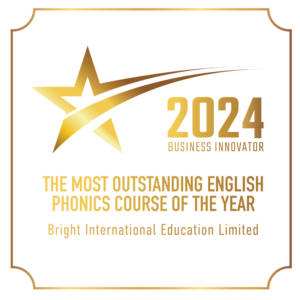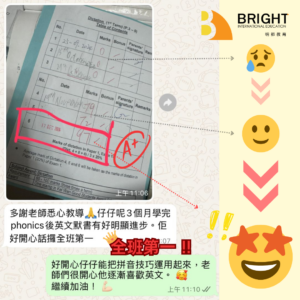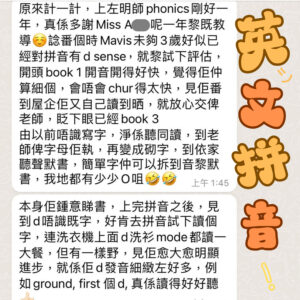


為什麼孩子需要學習英文拼音(Phonics)?
- 提高閱讀能力:通過學習英文拼音,孩子可以更容易地閱讀英文單字,並且可以更快地理解文章的意思.
- 增強記憶力:學習英文拼音需要不斷的練習,這將有助於增強孩子的記憶力。
- 提高語言能力:通過學習英文拼音,孩子可以更好地了解英語的發音和語音結構,從而提高語言能力。
- 提高自信心:學會了英文拼音,孩子會更有信心地使用英語,並更容易與他人交流。
- 提前準備未來學習:學習英文拼音是學習英語的重要基礎,它將有助於孩子在未來學習英語的過程中更順利。
- 更容易學習其他語言:學習英文拼音可以幫助學生建立對語音的敏銳度,這對他們日後學習其他語言也有所幫助。
Phonics和Phonetics(國際音標,IPA)有什麼分別?
在學習英語中,Phonics和Phonetics(國際音標,IPA)是兩種不同的教學方法。 雖然兩者都對幫助兒童發展語言能力很重要,但它們在語言學習中有明顯的重點和用途。
Phonics是關於英語字母和聲音之間的關係的研究。 它教導兒童如何通過辨別每個字母的聲音並融合聲音來拼讀/拼寫單詞。 Phonics通常用於教小孩閱讀,被認為是早期閱讀發展的關鍵組成部分。
另一方面,Phonetics(國際音標,IPA)是人類語言聲音的研究。 它使用國際音標(IPA)來表示英語的聲音,包括單獨的元音和輔音,以及聲音產生、傳播和接收的方式。 Phonetics(IPA)促進理解英語的聲音,教授非母語者正確的英語發音。 至於哪種方法更適合兒童學習,這取決於孩子的需求。
對於學習初期, 年紀較細的孩子,Phonics通常比Phonetics更合適和有效。 Phonics專門設計用於教孩子們如何拼讀和拼寫新單詞,並在英文生字和句子中的字母和聲音之間建立聯繫。 Phonics專注於英文的實際應用,為孩子們提供閱讀和書寫英文所需的技能。 Phonetic主要是對語音的學術和理論研究。 雖然Phonetics可能很有趣和有富有資訊性,但對於剛剛開始學習閱讀的年幼兒童可能不是那麼直接相關。
一般來說,建議在孩子開始閱讀時使用Phonics教學,並在他們成為更高級的讀者並對更深入地探索語言科學感興趣時學習Phonetics。

英文拼音(Phonics)如何有效幫助英文默書串字
英文拼音可以幫助孩子將每個英文字母與其發音建立關聯性。使孩子可以通過學習每個字母的發音和如何與其他字母結合來形成單詞,從而通過英語拼音令孩子更好地理解單詞的組成和發音。
學習英文拼音也可以幫助學生提高英文聽力,更容易辨認出每個字母的正確發音。因此,學習英文拼音可以作為默寫串字的有力工具。更好地理解單詞的組成和發音。 這樣,孩子就可以更容易地識別和記憶單詞,並能在讀寫中使用這些單詞。 所以,語音學習對於説明孩子記憶單詞至關重要。
學習英文拼音涉及學習英語中每個字母或字母組合相關的聲音。 通過瞭解英語的拼音技巧,學生可以將聲音作為識別和回憶英文單詞拼寫的方法,這對於學習英語尤其有用。
英文拼音可以幫助學生發展他們的對英文的拼讀和拼寫技能,這涉及根據字母所代表的聲音拼出單詞。 例如,一個知道“B”發“b”音,“A”發“a”音, “T“發“t”音的學生可以通過把聲音混合在一起來拼讀/拼寫單詞“Bat”。 這有助於學生建立他們的閱讀流暢性和準確性。
此外,學習英文拼音也有助於默書串字的發展。 通過瞭解與每個字母相關的聲音,學生可以正確拼寫單詞。 例如,一個知道“B”發“b”音, “Ar“發“ar”音, “Er” 發“er”音的學生可以通過寫下使他們聽到的聲音的字母來拼寫單詞“Barber”。
總括而言,英文拼音(Phonics)提供了一種學習英語的系統方法,可以成為閱讀和拼寫發展的有價值工具。
有許多研究證明學習英文拼音有助於孩子記憶單詞。 以下是一些例子:
“The Phonics Teaching System and its Effect on Beginning Reading and Spelling Achievement” by J. Samuels, published in the Journal of Educational Psychology in 1979.
“The Simple View of Reading: A New Framework for Understanding and Teaching Reading Development” by G.H. McGuinness, published in the Journal of Research in Reading in 2004.
“The Impact of Phonics Instruction on Reading and Spelling Outcomes for Students with Learning Disabilities” by S.A. Coyne and R.L. Lipson, published in the Journal of Learning Disabilities in 2006.
“The Effectiveness of Phonics Instruction for Students in Grades K-2: A Meta-Analysis” by N.E. Anderson, D.H. Hiebert, and D. Scott, published in the Journal of Educational Psychology in 1990.
These are just a few examples of the many studies that have investigated the effectiveness of phonics instruction. They provide strong evidence for the use of phonics as a tool for helping children learn to read and spell words.
這些研究證明學習英文拼音對孩子記憶單詞的重要性。
學習英文拼音(Phonics)通常包括以下階段:
- 瞭解每個字母的發音並學會識別它們所代表的不同聲音。
- 學習將字母組合成音節的規則,包括拼音的應用。
- 通過讀英文拼音中的單詞和句子練習發音,直到能夠準確地產生聲音。
- 通過學習英文拼音中的新詞彙和短語來建立詞彙量,並練習它們的發音。
- 將英文拼音的使用與其他語言學習活動(如說話、聽力和閱讀)結合起來,以增強對語言的整體理解和掌握。
- 定期練習並尋求老師的反饋是提高發音和增強對使用拼音的信心的重要方法。
由零開始學習英文拼音 (Phonics)分為四個階段:
階段一:學習26個英文字母的發音,介紹以單元音拼讀技巧,及令小朋友掌握以單元音組成之詞彙,例如D-O-G, Dog;M-O-P, Mop;F-I-T, Fit等。
階段二:學習混合音(Blending Words):例如BL,CL,FR,PR等:例如CH,SH,QU等;及長響音:例如EE,OO,UE等,配合在階段一時學習的拼音技巧,小朋友大多能開始拼讀較長及多音節詞彙,例如T-U-CK SH-O-P, Tuck shop;T-OO-TH BR-U-SH, Toothbrush等。
階段三:學習英文拼音一些特定規律,如Magic E和Silent words 等等
階段四:(鞏固期):將階段一至三所學的發音及規則應用,透過拼讀句子、文章及故事,套用到日常英語學習之中,使小朋友對英文產生興趣及增加學習動機。
明師教育英文拼音班六大獨家教學特色:
1. 小班教學,一對四,老師更容易兼顧所有學生。
2. 注重口型和發音教學,及時監督和即時糾正錯誤地方。
3. 每一堂都有默書、練習,強化新舊知識記憶。
4. 配合獨家Phonics影片,提升課堂趣味,更便於課後鞏固知識。
5. 與家長互動,隨時掌握小朋友的最新學習動態。
6. 最大特色,真正做到聽聲默書
因材施教、靈活教學:每個小朋友的學習能力不同,我們不會為了趕課程進度,而忽略小朋友的接收能力,當發現問題時,會即時糾正發音和口型,調整課程計劃和安排。
以每星期 1-2 堂計算,坊間一般教育機構教授的課程大約需時10 個月,學生才能做到聽默英文單詞。更需要3年先可以畢業!
明師教育英文拼音班通過我們獨家有效的教學方法,讓學生快速掌握拼讀技巧並做到融會貫通,每星期只需 1 堂,3 個半月後就達到聽默基本英文單詞的能力,連 3 歲小朋友都可以輕鬆做到!大概1至1.5年可以完成整個拼音課程(坊間大概要3年時間) 而且我地學完係做到聽聲默書效果,坊間無㗎!
學習英文拼音(Phonics)的好處:
- 加強讀寫能力:通過學習拼音,學生可以更好地識別和拼寫英文單詞,因此可以提高他們的讀寫能力。
- 增加英文字彙量:通過學習拼音,學生可以更好地理解和記住英文單詞,因此可以增加他們的英文字彙量。
- 提高英文口語能力:學習拼音可以幫助學生更好地發音,因此可以提高他們的英文口語能力。
- 建立自信:學生通過學習拼音而實現的成就感和自信可以促進他們對學習的熱情和信心。
- 更容易學習其他語言:學習拼音可以幫助學生建立對語音的敏銳度,這對他們日後學習其他語言也有所幫助。







